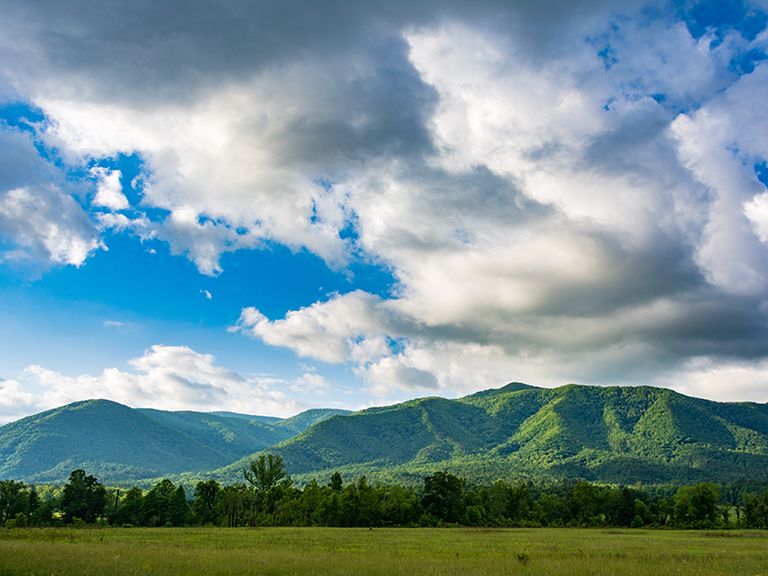If you’re planning to see the Smokies on an auto tour this fall, check out 3 popular drives below as well as some helpful tips for auto tourists in the Great Smoky Mountains National Park. Happy driving!
1.Cades Cove Loop Road
One of the most popular scenic drives in the national park, the Cades Cove Loop Road is an 11-mile road offering spectacular views from its lush, verdant valley. Even if you plan your visit in early autumn (mid to late September), Cades Cove still provides viewing access to the changing leaves at the higher peaks in the park. Not to mention, Cades Cove provides one of the best opportunities to see wildlife—including white-tailed deer and the symbol of the Smokies, the American black bear.
Other attractions along the Cades Cove Loop Road include early European settlements, which were built between 1818 and 1821. In fact, this area of the park offers the widest variety of historic buildings, such as churches, a working grist mill, barns, log houses, and more. Your pictures of these historic structures will be even more stunning with the variety of fall colors as their backdrop. So bring a light jacket, pack a picnic lunch, and be sure to get out and explore all that Cades Cove has to offer during your auto tour this fall!
2. Little River Road
A curvy road that spans 18 miles, Little River Road connects Gatlinburg with Townsend. You can use this road to access popular sites in the national park such as Cades Cove, the Elkmont Campground, the Greenbrier School, and Laurel Falls. But as you’re driving, you’ll find plenty to explore on this winding road that follows the Little River.
Some attractions to look forward to on a scenic drive of Little River Road are a variety of overlooks, trailheads, picnic areas (including Metcalf Bottoms), campground access points, and waterfalls. Actually, you can see two of these waterfalls from the road, and they are especially easy to spot in late fall, when summer’s full foliage has fallen from the trees. Enjoy the beauty of the river and the variety of foliage on Little River Road.
3.Roaring Fork Motor Nature Trail – OPEN AGAIN!
The closest motor vehicle trail to Gatlinburg, which isn’t too far from many of our Pigeon Forge cabins, is the beautiful, 5.5-mile, one-way loop known as the Roaring Fork Motor Nature Trail. Although buses, trailers, and RVs are not allowed on this road (read more about this in our “Tips for Auto Tourists” below), you can bring a caravan of small vehicles for a pleasant afternoon of Smoky Mountain fun.
While driving the Roaring Fork Motor Nature Trail, don’t miss the well-preserved log cabins, grist mills, and other historic buildings along the route. One of these—the Noah “Bud” Ogle mountain farmstead — can be found right before you enter the trail; just past the Ogle farmstead, you’ll find the trailhead to one of the park’s most popular waterfalls, Rainbow Falls. Try this 5.4-mile (roundtrip) hike when the weather is cool this fall.
Tips for Auto Tourists in the National Park
• Drive slow. Driving in the Smokies often means narrow turns, winding roads with blind spots, and low shoulders. That’s why speed limits in the park are generally 35 miles per hour or less. So take it slow, especially as you drive on new roads or unpaved ones.
• Check for closures. Because mountain roads are challenging to navigate even in the best weather conditions, the national park often enforces temporary road closures in periods of inclement weather. Sometimes, if you have a vehicle with four-wheel drive or tire chains, you’ll be allowed access, but this is not always the case. And some of the smaller roads stay closed for the duration of the winter months. Your best bet is to check with the National Park Service website directly for up-to-date information on road closures before you leave the cabin.*
• Check for restricted access. If you’re driving a large vehicle in the national park—a trailer, RV, and/or bus—please know that you won’t be able to drive on some secondary roads, including Greenbrier Road past the ranger station, the road that exits that park at Metcalf Bottoms Picnic Area, and the Roaring Fork Motor Nature Trail.
• Pay attention to your engine and brakes. Driving uphill, especially on a warm day, can cause your engine temperature to spike, so be sure to check for overheating. Pull over immediately if this occurs, and wait for your engine to cool down before continuing. On the return trip, as you’re driving downhill, you’ll need to watch for signs of your brakes overheating and potentially failing.
• Use a map, not your GPS. Although your GPS or vehicle navigation system is handy, it may not always be accurate on these sometimes treacherous mountain roads. You could find yourself going the wrong direction on a one-way road or end up at a dead end in a remote area of the park. Avoid both by using a park road map instead. You can pick one up for FREE at any visitor’s center in the national park.
• Fill up on gas. Please be advised that there are NO gas stations within the parameters of the Great Smoky Mountains National Park. So be sure to fill up your tank before you start your auto tour to avoid being stuck on the side of the road.
*Many of our Pigeon Forge Cabins offer free wireless internet access during your stay. Be sure to ask our reservation specialists for a list of cabins with this convenient feature!


